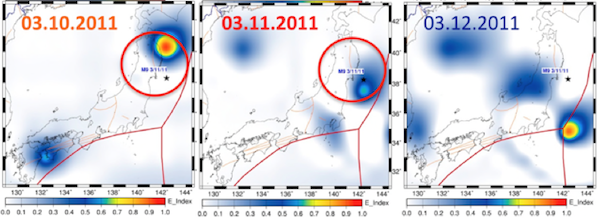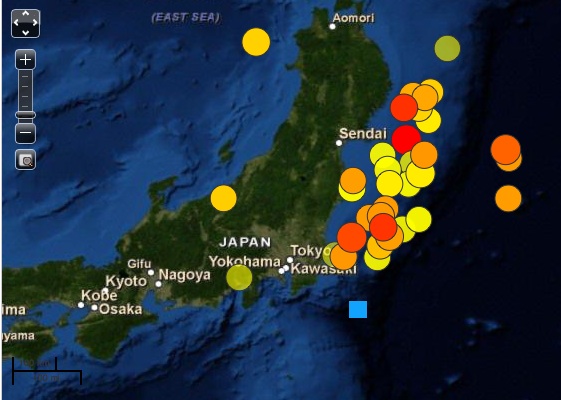![]() There is currently no reliable way to predict exactly when a big earthquake will occur. Nonetheless, whenever a large earthquake does wreak havoc on some unfortunate corner of the globe, there is an almost one hundred percent certainty that at some point over the following couple of months, someone will publish some research which will indicate that there was some physically measurable precursor signal detected in the days before the earthquake. The Tohuku earthquake is no exception, and this time the ‘precursor’ of choice is an ionospheric temperature anomaly that a study just uploaded to the arxiv (and therefore yet to be peer reviewed) claims to have detected above the epicentre of March’s magnitude 9 earthquake off the coast of eastern Honshu, in the three or four days just before the rupture. As explained here, the proposed mechanism for this heating is that radon gas released from the vicinity of the fault as it prepares to rupture ionises the air above, triggering condensation of water vapour and the release of latent heat.
There is currently no reliable way to predict exactly when a big earthquake will occur. Nonetheless, whenever a large earthquake does wreak havoc on some unfortunate corner of the globe, there is an almost one hundred percent certainty that at some point over the following couple of months, someone will publish some research which will indicate that there was some physically measurable precursor signal detected in the days before the earthquake. The Tohuku earthquake is no exception, and this time the ‘precursor’ of choice is an ionospheric temperature anomaly that a study just uploaded to the arxiv (and therefore yet to be peer reviewed) claims to have detected above the epicentre of March’s magnitude 9 earthquake off the coast of eastern Honshu, in the three or four days just before the rupture. As explained here, the proposed mechanism for this heating is that radon gas released from the vicinity of the fault as it prepares to rupture ionises the air above, triggering condensation of water vapour and the release of latent heat.
Properly assessing whether this result is reliable is beyond my technical knowledge, although other people seem unconvinced. Either way, this study perfectly illustrates one of the major issues that plagues every study of possible earthquake precursors that I’ve ever seen. Whatever the proposed signal is – be it radon gas, low frequency radio waves, ocean temperature, or even animal behaviour – it usually proves to not be uniquely associated with earthquakes. In other words, although you may sometimes see the ‘precursor’ prior to some sort of seismic activity, there are also many occasions where you see the signal and nothing of any significance happens. An examination of the data presented by NASA scientist Dimitar P Ouzounov and his coauthors in the arxiv paper appears to show the same old false positives in action. Below I’ve excerpted part of their Figure 1, which shows their calculated heat anomalies above Japan for 10-12 March. The magnitude 9 earthquake on the 11th falls within the red circle – as does a strong apparent anomaly on the 10th and 11th.

Calculated atmospheric temperature anomalies over Japan from 10-12 March 2001. Source: Ouzounov et al.
So far, so good: but I can’t help noticing an equally strong anomaly showing up on the plot for the 12th of March. It’s located some distance to the southeast, at around the point where the three subduction zones that converge off the coast of Japan meet. Did this signal, as strong as the one that supposedly heralded the magnitude 9 mainshock on March 11, also herald a large earthquake? No. It was a long way from any of the major aftershocks of the Tohuku earthquake. It’s a false positive

Earthquakes of greater than magnitude 6 in the five days following the magnitude 9 mainshock. Blue square: approximate location of atmospheric IR anomaly calculated by Ouzounov et al. for 12th March. Source: USGS
The authors also show a three month time series of anomalous long-wave radiation (what they are using as a indicator of temperature anomalies) in a region around the Tohuku earthquake epicentre which is, as far as I can tell, equivalent to the red circle in the first figure above. The spike in the days prior to the mainshock shows up nicely, but it is by no means the only peak on this plot, and on at least 3 other occasions there is a significant deviation from the background (which must be rather variable and difficult to calculate) without any corresponding seismic activity (or at least, no magnitude 6 or greater earthquakes). More false positives.

Calculated atmospheric temperature anomalies within a 200 km radius of the March 11 Tohuku earthquake, Jan-March 2011. Source: Ouzounov et al.
I’m not pointing this out because I think that proposed precursors such as radon emissions and EM signals are not worth studying: there is enough evidence to suggest that some of these signals are indeed related in some way to tectonic processes in the subsurface. However, studies like this are often reported as a definitive step towards the holy grail: reliable, timely warnings of imminent seismic activity. The abundance of false positives is a clear indication that things are nowhere near this clear cut. When your ‘precursor’ signal is only associated with an earthquake one time in ten, or even one time in four, you’ve obviously still got a lot of work to do. Perhaps one day there will be some theoretical or technical breakthrough that allows us to distinguish real precursors from the noise. But until that day, whenever you read a story that describes some phenomenon that preceded a large earthquake, and dangles the carrot of true earthquake prediction, don’t just look at the headline event. Check for false positives.



Comments (2)